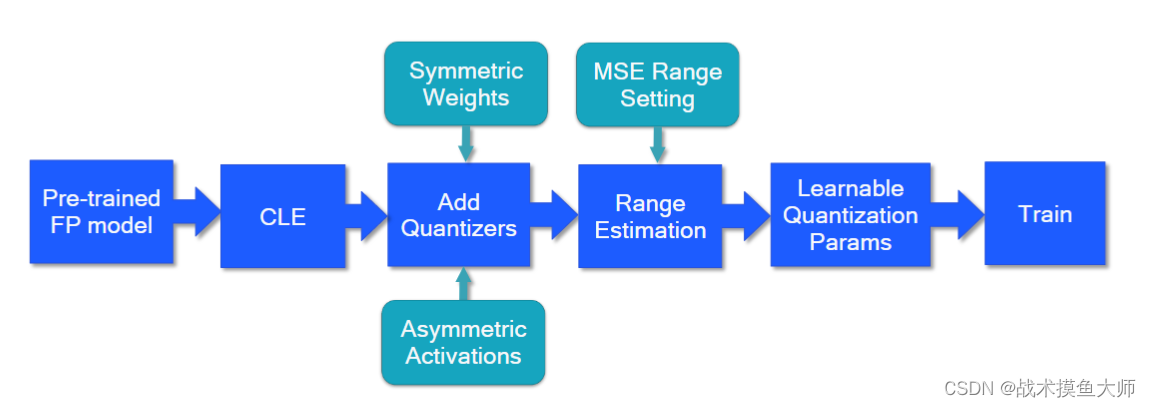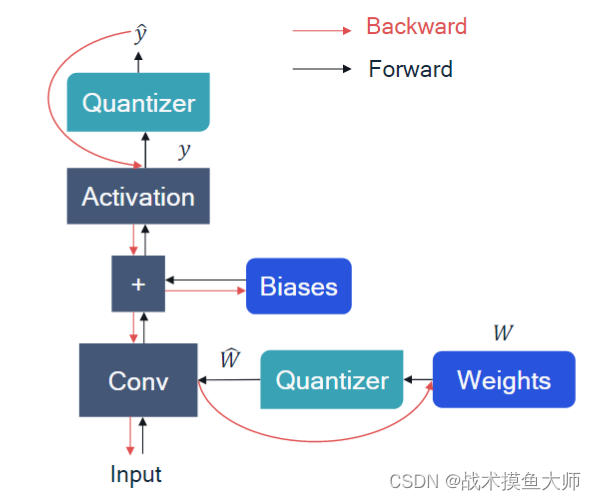量化方案
根据量化的时机可以分为训练时量化QAT和训练后量化PTQ。二者的工作流程图如下:

QAT量化流程图

PTQ量化流程图
其中的CLE为层间放缩平衡Cross-Layer Equalization,在使用per_tensor粒度进行量化时,同一个tensor中可能数据不平衡情况很严重,尤其是在深度可分离卷积中,非常影响量化性能,所以为了解决这个问题提出的,大致可以理解为对于前后两层,前面一层的参数放大s倍,后面一层的参数缩小s倍,那么最后的输出结果不会有太大变化。关于CLE后面在量化性能调优的blog里面讲
PTQ
其中PTQ又分为PTDQ和PTSQ两种方案,二者的主要区别是对于activation的处理不同。具体区别如下:
PTDQ
Post Training Dynamic Quantization,训练后动态量化,也就是在模型训练收敛后进行量化,weight进行量化,而activation则是在推理过程中进行动态计算scale和offset,进行动态量化。
这种方案是最简单的量化方案,主要用于模型参数加载较为费时的模型,如LSTM和transformer。
具体的参数类型如下:
# original model
# all tensors and computations are in floating point
previous_layer_fp32 -- linear_fp32 -- activation_fp32 -- next_layer_fp32/
linear_weight_fp32# dynamically quantized model
# 只有weight变成了int8,activation还是fp32
previous_layer_fp32 -- linear_int8_w_fp32_inp -- activation_fp32 -- next_layer_fp32/linear_weight_int8
pytorch demo代码如下:
import torch# define a floating point model
class M(torch.nn.Module):def __init__(self):super().__init__()self.fc = torch.nn.Linear(4, 4)def forward(self, x):x = self.fc(x)return xmodel_fp32 = M()
# create a quantized model instance
model_int8 = torch.ao.quantization.quantize_dynamic(model_fp32, # the original model{torch.nn.Linear}, # 自己选择要进行量化的层dtype=torch.qint8) # 量化后参数的存储类型# run the model
input_fp32 = torch.randn(4, 4, 4, 4)
res = model_int8(input_fp32)
PTSQ
Post Training Static Quantization,训练后静态量化。
与PTDQ的不同在于,PTSQ是把weight和activation的量化都提前做好,等到推理时不需要涉及到任何计算scale和offset的工作。对于activation的量化,PTSQ会尽量把它融合到前一层中,跟一层的layer一块儿量化。
这种方案适合读取参数和计算都比较耗时的模型,读取参数时间和计算时间都减少了。但是需要采用典型的数据进行校准,用于提前计算activation的scale和offset。
pytorch中PTSQ的方案需要自己定义量化器和解量化器,并且自己定义哪里开始量化,哪几层进行融合。
# original model
previous_layer_fp32 -- linear_fp32 -- activation_fp32 -- next_layer_fp32/linear_weight_fp32# statically quantized model
# 将linear和activation融合到了一块儿
previous_layer_int8 -- linear_with_activation_int8 -- next_layer_int8/linear_weight_int8
pytorch代码如下:
import torch# define a floating point model where some layers could be statically quantized
class M(torch.nn.Module):def __init__(self):super().__init__()self.quant = torch.ao.quantization.QuantStub() # 量化器self.conv = torch.nn.Conv2d(1, 1, 1)self.relu = torch.nn.ReLU()self.dequant = torch.ao.quantization.DeQuantStub() # 解量化器def forward(self, x):x = self.quant(x) # 将x量化,由FP32变成int8x = self.conv(x)x = self.relu(x)x = self.dequant(x) # 解量化,由int8变回FP32return x# create a model instance
model_fp32 = M()model_fp32.eval()model_fp32.qconfig = torch.ao.quantization.get_default_qconfig('x86')# Common fusions include `conv + relu` and `conv + batchnorm + relu`
model_fp32_fused = torch.ao.quantization.fuse_modules(model_fp32, [['conv', 'relu']])
model_fp32_prepared = torch.ao.quantization.prepare(model_fp32_fused)input_fp32 = torch.randn(4, 1, 4, 4) //典型数据
model_fp32_prepared(input_fp32) //校准,计算scale和offsetmodel_int8 = torch.ao.quantization.convert(model_fp32_prepared) //模型转化res = model_int8(input_fp32) //推理
QAT
边量化边训练,训练过程还是浮点数运算,不过会进行量化模拟,模拟量化以查看效果,本来训练是使loss最小,QAT情况下的训练是:使量化模拟后的模型loss最小。
关于量化模拟在之前提到过,详见:tensor量化
加入量化器后出现的一个问题就是:反向传播的时候,量化模拟器怎么求导?量化模拟器求导的结果要么是0要么就是不存在,所以这里引入直通估计,也就是假设四舍五入函数 r o u n d ( x ) round(x) round(x)的导数为1,也就是不影响求导,最终的反向传播效果如下:
量化前后数据流图:
# original model
previous_layer_fp32 -- linear_fp32 -- activation_fp32 -- next_layer_fp32/linear_weight_fp32# 量化模拟,在其中加入了很多量化器,为了模拟量化产生的精度损失,数据依旧使fp32类型
previous_layer_fp32 -- fq -- linear_fp32 -- activation_fp32 -- fq -- next_layer_fp32/linear_weight_fp32 -- fq# 真实量化过的模型,全部都是int8
previous_layer_int8 -- linear_with_activation_int8 -- next_layer_int8/linear_weight_int8
demo代码:
import torch# define a floating point model where some layers could benefit from QAT
class M(torch.nn.Module):def __init__(self):super().__init__()self.quant = torch.ao.quantization.QuantStub() //量化器self.conv = torch.nn.Conv2d(1, 1, 1)self.bn = torch.nn.BatchNorm2d(1)self.relu = torch.nn.ReLU()self.dequant = torch.ao.quantization.DeQuantStub() //解量化器def forward(self, x):x = self.quant(x)x = self.conv(x)x = self.bn(x)x = self.relu(x)x = self.dequant(x)return xdef training_loop(model):pass# create a model instance
model_fp32 = M()
model_fp32.eval()model_fp32.qconfig = torch.ao.quantization.get_default_qat_qconfig('x86')# 算子融合,将多个算子融合为一个
model_fp32_fused = torch.ao.quantization.fuse_modules(model_fp32,[['conv', 'bn', 'relu']])# 准备量化
model_fp32_prepared = torch.ao.quantization.prepare_qat(model_fp32_fused.train())# 训练
training_loop(model_fp32_prepared)model_fp32_prepared.eval()
model_int8 = torch.ao.quantization.convert(model_fp32_prepared)res = model_int8(input_fp32)
pytorch对于量化的实现
量化算法支持
回归到最底层的tensor量化,有两种量化粒度:per_tensor和per_channel,两种量化方法:对称量化,非对称量化。一共2*2=4种选择,所以pytorch也提供了4种方法:
import torch
torch.per_tensor_affine # 非对称
torch.per_tensor_symmetric # 对称
torch.per_channel_affine
torch.per_channel_symmetric
量化不仅仅需要进行模型融合,加入量化算法支持,还需要对tensor进行修改,原本的tensor只需要存储数据,现在对于量化过的INT8 tensor,还需要存储scale和offset。所以pytorch针对量化后的tensor提供了新的类型:
import torch
torch.quint8
torch.qint8
torch.qint32
torch.float16
关于config,类型转化等,详见官方文档:官方文档
如果觉得有帮助,请点赞收藏+关注,thanks




![[LeetBook]【学习日记】有效数字——状态机](http://pic.xiahunao.cn/[LeetBook]【学习日记】有效数字——状态机)


——线性表的基本操作)
)











